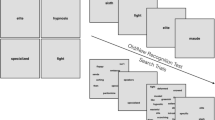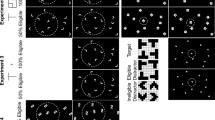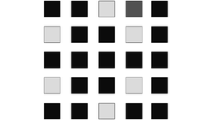Summary
The performance in the Trail Making Test (Form A) was correlated with a variety of verbal and nonverbal tests in 5 groups of patients: Broca's aphasies (N= 18), Wernicke's aphasics (N= 19) and nonaphasic patients with right hemisphere (N= 20), left hemisphere (N= 17) or diffuse (N= 18) lesions. Correlations with the Trail Making Test were found for two tests, both requiring visual search. The “Objects Finding Test” in which the target varies from item to item showed high correlations for all groups of patients. The “Hidden Patterns Test”, in which the target is kept constant, correlated only on the groups of nonaphasic patients. It is concluded (1) that visual search, as tested here, is not restricted to lateralized cortical functions, and (2) that the performance in the Trail Making Test depends largely upon processes involved in visual search of varying targets.
Zusammenfassung
Der Trail Making Test (Form A) dient gewöhnlich der Diagnose des allgemeinen Schweregrads von Hirnschädigungen verschiedenster Lokalisation und Genese. Der Patient hat dabei 25 unregelmäßig über ein Blatt verteilte Kreise in numerisch angegebener Reihenfolge so schnell wie möglich durch Bleistiftstriche miteinander zu verbinden. Mittels Korrelationen wurde die Beziehung verschiedener verbaler wie nonverbaler Tests zur Testleistung im Trail Making Test bei fünf Patientengruppn untersucht: Broca-Aphasiker (N=18), Wernicke-Aphasiker (N=19) und Hirngeschädigte ohne Aphasie mit rechtshemisphärischen (N =20), linkshemisphärischen (N=17) oder diffusen (N=18) Läsionen. Zwei Tests, bei denen visuelle Suchleistungen gefordert waren, korrelierten mit dem Trail Making Test. Beim Test „Objekte Finden“, der die Suchleistung anhand wechselnder Suchobjekte prüft, ergaben sich Korrelationen bei allen Patientengruppen. Der „Hidden Patterns Test“, bei dem das Suchobjekt konstant bleibt, korrelierte nur bei nichtaphasischen Patientengruppen mit den Leistungen im Trail Making Test. Nach der vorliegenden Untersuchung scheinen visuelle Suchleistungen, insbesondere bei variablen Suchobjekten, weitgehend unabhängig von der Lokalisation der Hirnschädigung zu sein und eng mit den Leistungen im Trail Making Test zusammenzuhängen.
Similar content being viewed by others
References
Angermaier M (1974) Psycholinguistischer Entwicklungstest. Beltz, Weinheim
Armitage S (1946) Analysis of certain psychological tests used for the evaluation of brain damage. Psychol Monogr 60: No. 1 (whole issue)
Barnes GW, Lucas GJ (1974) Cerebral dysfunction vs. psychogenesis in Halstead-Reitan tests. J Nerv Ment Dis 158:50–60
Boll TJ (1981) The Halstead-Reitan neuropsychology battery. In: Filsko SB, Boll TJ (eds) Handbook of clinical neuropsychology. Wiley, New York, pp 577–607
Chédru F, Leblanc M, Lhermitte F (1973) Visual searching in normal and brain-damaged subjects: Contribution to the study of unilateral inattention. Cortex 9:94–111
Cohen R, Ehrenstein WH, Woll G (1979) Experimentalpsychologische Untersuchungen zur Erfassung aphasischer Störungen. Research report to the Deutsche Forschungsgemeinschaft, University Press, Konstanz
Corkin S (1979) Hidden-figures-test performance: Lasting effects of unilateral penetrating head injury and transient effects of bilateral cingulotomy. Neuropsychologia 17:585–605
French JW, Ekstion RB, Price LA (1963) Kit of reference tests for cognitive factors. Educational Testing Service, Princeton, NJ, USA
Friedland RP, Weinstein EA (1977) Hemi-Inattention and hemisphere specialisation. In: Friedland PP, Weinstein EA (eds) Advances in neurology. Vol 18. Raven Press, New York, pp 1–31
Gordon NG (1972) The Trail Making Test in neuropsychological diagnosis. J Clin Psychol 28:167–169
Hartje W, Orgass B, Poeck K, Kerschensteiner M (1974) Störungen des visuellen Erkennens nach einseitiger Hirnschädigung. Nervenarzt 45:67–72
Kirk SA, McCarthy JJ, Kirk WD (1968) Illinois Test of psycholinguistic abilities. University of Illinois Press, Urbana, Ill, USA
Oldfield RC (1971) The assessment and analysis of handedness: the Edinburgh Inventory. Neuropsychologia 9:97–113
Pizzamiglio L, Carli R (1974) Visual, tactile and acoustic embedded figure tests in patients with unilateral brain damage. Cortex 10:238–246
Prinz W (1979) Integration of information in visual search. Q J Exp Psychol 31:287–304
Rabbitt P (1978) Sorting, categorization and visual search. In: Carterette EC, Friedman MP (eds) Handbook of perception, Vol IX, chapter 3. Academic Press, New York
Reitan RM (1958) The validity of the Trail Making Test as an indicator of organic brain damage. Percept Mot Skills 8:271–276
Reitan RM (1959) A manual for the administrating and scoring of the Trail Making Test. Indiana University Press, Indianapolis, IN, USA
Reitan RM (1966) A research program on the psychological effects of brain lesions in human beings. In: Ellis NR (ed) International review of research in mental retardation. Academic Press, New York, pp 153–218
Reitan RM, Tarshes EL (1959) Differential effects of lateralizing brain lesions on the Trail Making Test. J Nerv Ment Dis 129:257–262
Russo M, Vignolo LA (1967) Visual figure-ground discrimination in patients with unilateral cerebral disease. Cortex 3:113–127
Teuber HL, Weinstein S (1956) Ability to discover hidden figures after cerebral lesions. Arch Neurol Psychiatr (Chicago) 76:369–379
Author information
Authors and Affiliations
Rights and permissions
About this article
Cite this article
Ehrenstein, W.H., Heister, G. & Cohen, R. Trail Making Test and visual search. Arch Psychiatr Nervenkr 231, 333–338 (1982). https://doi.org/10.1007/BF00345589
Received:
Issue Date:
DOI: https://doi.org/10.1007/BF00345589




